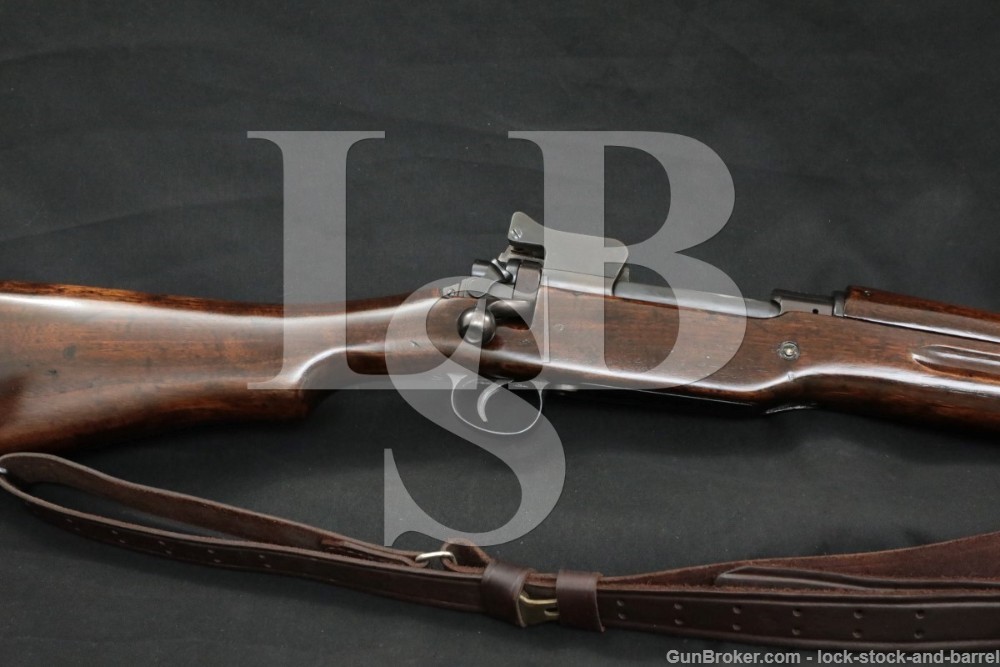
Winchester Model 1917 American Enfield 30-06 Bolt Action Rifle 1917 C&R
SOLD FOR: $1601
LSB#: 210415BB05
Make: Winchester
Model: 1917
Serial Number: 24407
Year of Manufacture: Barrel Date: August 1917, “8-17”
Production ran from August, 1917 to April, 1919 (page 129 of Charles Stratton’s book, British Enfield Rifles Volume 4 – The Pattern 1914 and U.S. Model 1917 Rifles).
Caliber: .30-06 Springfield
Action Type: Bolt Action, Internal Magazine
Markings: The import mark on the bottom of the barrel reads “P1917 30 06cal CDI, SWAN VT.”. The top of the receiver is marked “U.S. / MODEL OF 1917 / WINCHESTER / 24407”. The front of the Winchester barrel is marked “W / flaming bomb / 8-17”. The left side of the receiver and the top of the bolt handle are both marked with an Ordnance Department “flaming bomb” proof. The top left of the receiver is marked with 2 “eagle head” inspection stamps. The bottom of the bolt handle is marked “SN / W” and the top is marked “24407”. The bottom of the firing pin lug is marked “R”. The floorplate tang is marked with an eagle head. The bayonet lug is marked “W”. The nose of the forend is marked “P”. There is what looks like a faded star on the left of the receiver. The bottom of the wrist is stamped “10” and with an eagle head. There are a few more small markings.
Barrel Length: Approximately 26 Inches
Sights / Optics: The front sight is a post set between 2 protective ears. The rear sight is set between two large protective wings. It is an aperture when down. When flipped up it becomes a sight ladder that uses a sliding aperture. The ladder is marked from “2-16”.
Stock Configuration & Condition: The hardwood stock has cutouts for the bolt handle & safety, finger grooves, nosecap, stacking loop, 2 sling loops, through bolt, reinforcing pin, and a metal buttplate with a hinged door for storage. The buttplate shows erosion under the finish, oxidation, and some finish loss. The wood has been refinished and shows scattered dings, light scrapes, compressions, and draglines, most under the new finish. There are a few little pools of excess finish and there are other spots of thinned finish. There is what looks like a little repair on the bottom of the forend. The LOP measures 13 ½ inches from the front of the trigger to the back of the buttplate. The stock rates in about Very Good overall condition.
Type of Finish: Blued
Finish Originality: Refinished
Bore Condition: The bore is mostly bright with sharp rifling. There is no erosion. The bore shows an M.E. of 2.0.
Overall Condition: This rifle retains about 95% of its current metal finish as refinished. There are some spots of scattered surface oxidation, most noticeable on the receiver. There is some light wear on the bottom metal from use. The barrel has a few little marks under the finish and some scattered surface frost. The bolt has some standard operational wear and there is s bit of finish loss on the bolt knob on the underside. There are some little scuffs and spots of thinning on the bolt knob. There is standard operational wear. The screw heads show use. Most of the markings are clear. Overall, this rifle rates in about Very Good condition as refinished.
Mechanics: The action functions correctly. We did not fire this rifle. As with all used firearms, a thorough cleaning may be necessary to meet your maintenance requirements.
Box, Paperwork & Accessories: Included is a Hunter leather sling in about Fine condition with some light wear from use.
Our Assessment: This Winchester Model 1917 is in Nice shape for being 100 yrs old. This is an attractive rifle that can still put a lot of lead down range. It has nice markings on the metal including “flaming bombs” and “eagle heads” that add to the historical value of the rifle. The M1917 Enfield…formally named “United States Rifle, cal .30, Model of 1917” was an American modification and production of the British .303 caliber P14 rifle developed and manufactured during the period 1917-1918….As it entered World War I, the UK had an urgent need for rifles, and contracts for the new rifle were placed with arms companies in the United States. They decided to ask these companies to produce the new rifle design in the old .303 caliber for convenience of supply. The new rifle was termed the “Pattern 14”. In the case of the P14 rifle, Winchester and Remington were selected. A third manufacturer, Eddystone Arsenal – a subsidiary of Remington – was tooled up at the Baldwin Locomotive Works in Eddystone, Pennsylvania. Thus, three variations of the P14 and M1917 exist, labeled “Winchester,” “Remington” and “Eddystone”. When the U.S. entered the war, it had a similar need for rifles. The Springfield Armory had delivered approximately 843,000 M1903 rifles, but due to the difficulties in production, rather than re-tool the Pattern 14 factories to produce the standard U.S. rifle, the M1903 Springfield, it was realized that it would be much quicker to adapt the British design for the U.S. .30-06 cartridge, for which it was well-suited. Accordingly, Remington Arms Co. altered the design for caliber .30-06, under the close supervision of the U.S. Army Ordnance Department, which was formally adopted as the U.S. Rifle, Caliber .30, Model of 1917. Please see our photos and good luck!

